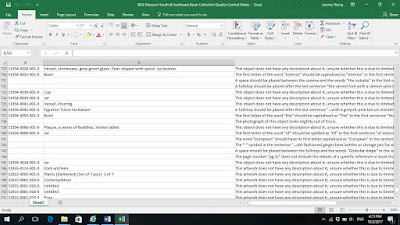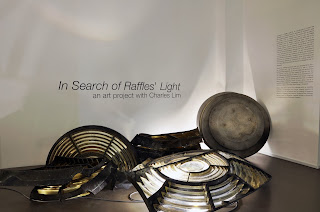Diary of an NUS Museum Intern: Jeremy Wong
Note: Diary of an NUS Museum Intern is a series of blog posts written by our interns about their experiences during the course of their internships. Working alongside their mentors, our interns have waded through tons of historical research, assisted in curatorial work, pitched in during exhibition installations and organised outreach events! If you would like to become our next intern, visit our internship page for more information!
-
Jeremy Wong is a third-year Ancient World, Politics and International Studies student at the University of Melbourne. During his time as Collections Intern at the NUS Museum, Jeremy assisted the Collections team with organizing the collections data, art handling and research.
I knew I was
in for an interesting ride as the Collections Intern at the NUS Museum. After
all, I had to check approximately around 865 digital records of the museum’s
collection, I was the only University of Melbourne student amongst my fellow
interns and had to handle more artifacts and artworks than my whole semester
load of ancient Egyptian subjects. So yes, a definite step up from the weekly
tutorial discussions of touching and examining ancient Egyptian ceramics and
funerary figures. I was tasked with vetting the digital records in the NUS
Museum’s online collections database, checking for spelling, grammar,
punctuation errors along with any presentation improvements I could suggest to
help improve the online collections database records.
Naturally
online dictionaries become one of my faithful companions during this quest of
vetting the museum’s online collections database as I found my vocabulary
expanding due to my constant checking for the definitions of words such as
oeuvre and islets. Some records were reasonably easy to check as the only
errors were minor spelling or grammar mistakes. However, there were some days
where I would spend a good amount of time staring at the object’s record and
attempting to decipher the original meaning of odd sentences like ‘by many said
to be superior to the very best Penang’ to present a better rephrasing of these
sentences for viewers. Due to the focus of my Ancient World Studies major in
Melbourne University on ancient Roman, Greek, Egyptian and Near Eastern
civilisations, I found myself learning more about the histories and material
cultures of civilisations from different Chinese, Southeast and South Asian
periods such as the longquan celadon wares and the meanings of different Buddha
statue poses like varada mudra meaning compassion. And thanks to my checks of
the digital records of the museum’s collection, I have been able to add interesting
places like the Goa Gajah or Elephant Cave in Bali to my travel list, so who
says careful evaluations cannot be rewarding?
One of the few documents containing my notes on all the spelling,
punctuation, grammar and presentation errors for the museum’s online collection
database. Will be working on making this presentable in a song and dance performance
in the future.
Thanks to the other assignment given to all
the interns to produce a gallery guide on the exhibition Radio Malaya: Abridged Conversations about Art, I found myself
learning and being fascinated by the art, literary, political and social
history of my home country. I must admit though, my work on the gallery guide
started with plenty of confusion on my part, as Singaporean art history was a
significant gap in my knowledge and therefore Singaporean artists like Ng Eng
Teng and Chen Wen Hsi were like strangers to my mind. I am grateful to
Michelle, Sidd and Ahmad for their openness to allow us interns to explore
topics that are of interest to us and so starting me on a journey to learning
more about how the independence period had a such profound impact on many
aspects of Singaporean society, politics and history. I am also particularly
grateful to Jonathan Tan who despite his responsibilities was willing to tell
me interesting pieces of information about the various artworks in the
exhibition and for giving me valuable suggestions and encouragement for my
gallery guide project.
Clearly our chairs were shedding tears every time we had to be away from
the office
Soon I was to discover that such checks are
only a small part of the Collections team’s responsibilities, as Donald brought
me along to observe and participate in other collections management work.
Physical handling of the various artifacts and artworks of the museum’s
collection extended beyond just placing selected objects in the museum’s
galleries for display, but also for condition checks and conservation
examinations by the curators and conservators respectively. It was interesting
to observe how Donald’s inputs and comments regarding the conditions of various
artifacts and artworks were all considered by the curators and conservators,
indicating that the Collections team are not just passive observers in the
interpretation of the museum’s collection.
Donald and myself unpacking objects for From the Ashes: Reviving Myanmar
Celadon Ceramics exhibition
As I participated in the various activities
of Collections management from packing paintings that were on loan to the
museum to be returned to their owners to helping unpack Myanmar ceramics for
the upcoming exhibition From the Ashes:
Reviving Myanmar Celadon Ceramics, I realised that many details must be
considered in Collections management work. Whether it is properly placing
paintings in a specific manner so that the wires of the back parts do not touch
the actual artworks or using specific light lux levels for different types of
artworks like Chinese scrolls, I found myself amazed at all these considerations
that Donald, Devi and the exhibition’s curator Su Ling shared with me in their
work so much so that the voice of Sherlock Holmes saying “Elementary, my dear
Watson” popped into my head as I recognised that putting on gloves to handle
artifacts in tutorials was only the first step in Collections management.
Lovingly handmade cardboard for the
packing of paintings
This attention to detail is not only for the
conservation of artifacts and artworks in the museum, but also extended to the
presentation of the exhibitions as me and Donald channeled our inner Bob the
Builder and went around touching up scuff marks, giving fresh coats of paint to
exhibition display features like a pedestal and parts of a display case and
placing in new acrylic holders to a newly hung up Chinese scroll painting. As I
continued helping with From the Ashes:
Reviving Myanmar Celadon Ceramics exhibition, I realised that visual
presentation of the exhibition went beyond aesthetical considerations as Donald
and Su Ling discussed potential issues such as whether placing some bowls or
portions of a figurine on a raised platform could mislead people into thinking
these objects are important. Even the texts on the exhibition’s walls are
placed in a specific fashion to communicate to visitors what is important and
peripheral information with regards to the exhibition, which served as a
reminder to myself that everything a museum does creates meanings and
interpretations to visitors whether intentional or not.
Myself (on the right) with fellow intern Clarice pretending to be
spooked
Liana, Clarice, myself and Sheena embracing our love for the Arts and
the occasional costume
This internship has been undoubtedly a
wonderful and unforgettable experience, allowing me to learn and further
appreciate the various works done in museums from the different methods to
store various objects to considering the impact of how a museum’s presentation
affects viewers’ interpretations. Despite learning of the various
responsibilities and activities that need to be done in museum work, it has
only increased my enthusiasm for museum work. I would like to thank Greg and
Michelle for giving me a chance to be the Collections Intern for the past 7-8
weeks and for their ever-patient supervision and advice. Also, I am very grateful to Donald and Devi
for putting their trust in me and allowing me to participate in various
Collections management activities and handle many precious artifacts. I would
also like to extend my appreciation to the other various NUS Museum staff like
Su Ling for her willingness to answer my various questions on curatorial work
and Myanmar ceramics, Freda for reading and implementing my long list of
corrections to the NUS Museum’s online collection, Wardah for her ever
interesting conversations in the office, JJ for always kindly helping us to
enter the office, the TJC interns Janessa, Valerie and Whitney for their help
in doing preparation works for the Radio
Malaya exhibition opening and for reminding me of my younger days along
with everyone else at the NUS Museum! And finally, to my fellow interns Sheena,
Liana and Clarice for the various fun conversations along with intriguing
discussions we had about our gallery guides, for introducing me to good places
to eat in NUS (I have learnt from the best) and for helping me to learn a
little more about Singapore through their remarks or discussions about
Singaporean artists and writers like Arthur Yap, Robert Yeo and Charlie Chan
Hock Chye. As I said in the beginning, this internship was going to be an
interesting ride, and what a ride it was for making me ever more passionate
about museum work.





Comments
Post a Comment